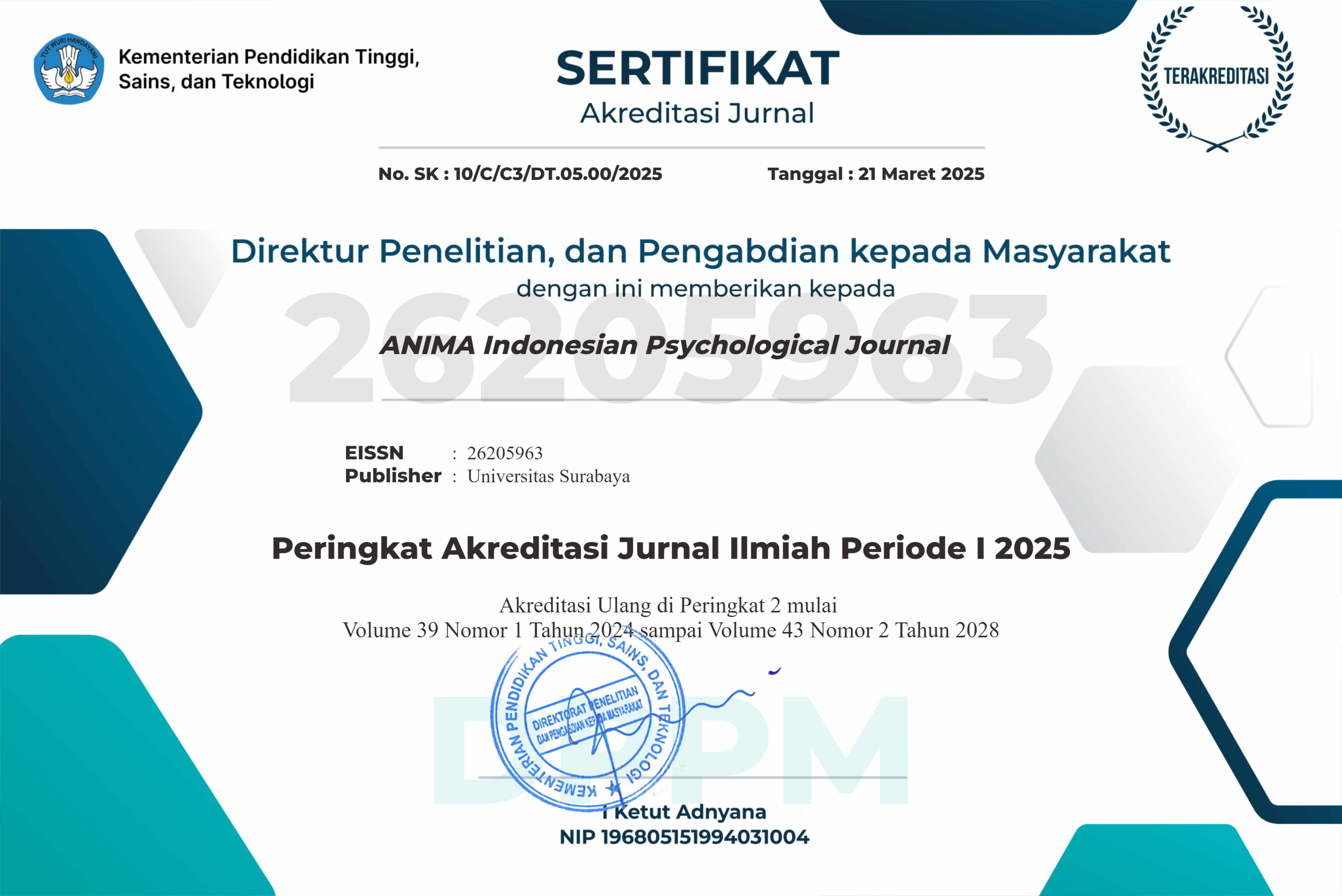Two Decades After Traumatic Events: Prevalence of Mental Health in Aceh Tsunami Survivors
 Abstract Views:
564 times
Abstract Views:
564 times
 PDF - Full Text Downloads:
296 times
PDF - Full Text Downloads:
296 times
 Video Downloads:
43 times
Video Downloads:
43 times
Abstract
The long-term psychological impact of a traumatic natural disaster, such as the 2004 Aceh Tsunami, is still poorly documented in the scientific literature. The purpose of this study was to describe the mental health status of survivors of the 2004 Aceh Tsunami 20 years after the Aceh Tsunami, utilizing a descriptive quantitative research design. The study participants were 197 tsunami survivors selected by purposive sampling, with specific criteria: (1) being victims directly exposed to the 2004 Aceh Tsunami; and (2) being members of the Aceh community. The Mental Health Inventory-18 (MHI-18; α = .93) was utilized as the data collection instrument for mental health in this study. The results of the data analysis showed that the majority of survivors (78.17%) had low mental health or psychological well-being, reflecting ongoing psychological disorders even though 20 years had passed since the disaster. The findings of this study indicate that the psychological impact of the Aceh Tsunami continues in the long term, significantly affecting psychological well-being. The results of this study emphasize the need for special attention to the mental health of disaster survivors, as well as the importance of long-term support programs to mitigate the long-term psychological impacts post-disasters.
Downloads
References
Afifi, M. (2007). Gender differences in mental health. Singapore Medical Journal, 48(5), 385-391. https://www.smj.org.sg/article/gender-differences-mental-health
Ahmed, O., Griffiths, M. D., & Hossain, M. A. (2022). Psychometric assessment of the 18-Item Bangla Mental Health Inventory (Bangla MHI-18). Psychological Studies, 67(1), 110-122. https://doi.org/10.1007/s12646-022-00645-y
Azwar, S. (2012). Penyusunan skala psikologi (Edisi ke-2) [Psychological scale development (2nd ed.)]. Pustaka Pelajar.
Blackmore, R., Boyle, J. A., Fazel, M., Ranasinha, S., Gray, K. M., Fitzgerald, G., Misso, M., & Gibson-Helm, M. (2020). The prevalence of mental illness in refugees and asylum seekers: A systematic review and meta-analysis. Public Library of Science (PLoS) Medicine, 17(9): e1003337. https://doi.org/10.1371/journal.pmed.1003337
Bonanno, G. A., Brewin, C. R., Kaniasty, K., & Greca, A. M. L. (2010). Weighing the costs of disaster: Consequences, risks, and resilience in individuals, families, and communities. Psychological Science in the Public Interest, 11(1), 1-49. https://doi.org/10.1177/1529100610387086
Eray, Ş., Uçar, H. N., & Murat, D. (2017). The effects of relocation and social support on long-term outcomes of adolescents following a major earthquake: A controlled study from Turkey. International Journal of Disaster Risk Reduction, 24, 46-51. https://doi.org/10.1016/j.ijdrr.2017.05.026
Faiza, F., & Amna, Z. (2017). Bullying dan kesehatan mental pada remaja sekolah menengah atas di Banda Aceh [Bullying and mental health of senior high school adolescents in Banda Aceh]. Gender Equality: International Journal of Child and Gender Studies, 3(1), 77-84. https://doi.org/10.22373/equality.v3i1.1950 | https://jurnal.ar-raniry.ac.id/index.php/equality/article/view/1950
Frankenberg, E., Friedman, J., Gillespie, T., Ingwersen, N., Pynoos, R., Rifai, I. U., Sikoki, B., Steinberg, A., Sumantri, C., Suriastini, W., & Thomas, D. (2008). Mental health in Sumatra after the tsunami. American Journal of Public Health, 98(9), 1671-1677. https://doi.org/10.2105/AJPH.2007.120915
Gao, W., Ping, S., & Liu, X. (2020). Gender differences in depression, anxiety, and stress among college students: A longitudinal study from China. Journal of Affective Disorders, 263, 292-300. https://doi.org/10.1016/j.jad.2019.11.121
Galea, S., Nandi, A., & Vlahov, D. (2005). The epidemiology of post-traumatic stress disorder after disasters. Epidemiologic Reviews, 27, 78-91. https://doi.org/10.1093/epirev/mxi003
Généreux, M., Schluter, P. J., Takahashi, S., Usami, S., Mashino, S., Kayano, R., & Kim, Y. (2019). Psychosocial management before, during, and after emergencies and disasters—Results from the Kobe expert meeting. International Journal of Environmental Research and Public Health, 16(8): 1309. https://doi.org/10.3390/ijerph16081309
Haerana, B. T., Jamaluddin, A. R., Sadarang, R. A. I., Rachman, I., & Humang, R. I. (2022). Dampak tsunami terhadap kesehatan mental anak [The effects of tsunami on child mental health]. Jurnal Penelitian Kesehatan “Suara Forikes”, Nomor Khusus Hari AIDS Sedunia, Desember 2022, 26-30. https://doi.org/10.33846/sf13nk406 | https://forikes-ejournal.com/index.php/SF/article/view/sf13nk406
Hamzah, H., Panatik, S. A., Perveen, A., & Ramlee, F. (2022). Reliability and validity of the Malay version of Mental Health Inventory-18. International Journal of Academic Research in Business and Social Sciences, 12(2), 216-228. https://doi.org/10.6007/IJARBSS/v12-i2/12276
Irmansyah, I., Dharmono, S., Maramis, A., & Minas, H. (2010). Determinants of psychological morbidity in survivors of the earthquake and tsunami in Aceh and Nias. International Journal of Mental Health Systems, 4: 8. https://doi.org/10.1186/1752-4458-4-8
Khan, M. J., Hanif, R., & Tariq, N. (2015). Translation and validation of Mental Health Inventory. Pakistan Journal of Psychological Research, 30(1), 65-79. https://psycnet.apa.org/record/2016-36971-004
Kino, S., Aida, J., Kondo, K., & Kawachi, I. (2021). Persistent mental health impacts of disaster. Five-year follow-up after the 2011 great east Japan earthquake and tsunami: Iwanuma Study. Journal of Psychiatric Research, 136, 452-459. https://doi.org/10.1016/j.jpsychires.2020.08.016
Lipinski, K., Liu, L. L., & Wong, P. W. C. (2016). The effectiveness of psychosocial interventions implemented after the Indian Ocean Tsunami: A systematic review. International Journal of Psychiatry, 62(3), 271-280. https://doi.org/10.1177/0020764015623807
McFarlane, A. C., & Williams, R. (2012). Mental health services required after disasters: Learning from the lasting effects of disasters. Depression Research and Treatment, 2012: 970194. https://doi.org/10.1155/2012/970194
McFarlane, A. C. (2010). The long-term costs of traumatic stress: Intertwined physical and psychological consequences. World Psychiatry: Official Journal of the World Psychiatric Organization (WPA), 9(1), 3-10. https://doi.org/10.1002/j.2051-5545.2010.tb00254.x
McKinzie, A. E., & Clay-Warner, J. (2021). The gendered effect of disasters on mental health: A systematic review. International Journal of Mass Emergencies & Disasters, 39(2), 227-262. https://doi.org/10.1177/028072702103900202
Meng, Z., Wu, X., & Han, L. (2018). Post-traumatic stress disorder and post-traumatic growth among the adult survivors of the Lushan earthquake: Selecting resilience as the moderator. International Journal of Disaster Risk Reduction, 27, 524-529. https://doi.org/10.1016/j.ijdrr.2017.11.016
Neria, Y., Nandi, A., & Galea, S. (2008). Post-traumatic stress disorder following disasters: A systematic review. Psychological Medicine, 38(4), 467-480. https://doi.org/10.1017/S0033291707001353
Neuner, F., Schauer, E., Catani, C., Ruf, M., & Elbert, T. (2006). Post-tsunami stress: A study of posttraumatic stress disorder in children living in three severely affected regions in Sri Lanka. Journal of Traumatic Stress, 19(3), 339-347. https://doi.org/10.1002/jts.20121
Newnham, E. A., Mergelsberg, E. L., Chen, Y., Kim, Y., Gibbs, L., Dzidic, P. L., DaSilva, M. I., Chan, E. Y. Y., Shimomura, K., Narita, Z., Huang, Z., & Leaning, J. (2022). Long term mental health trajectories after disasters and pandemics: A multilingual systematic review of prevalence, risk and protective factors. Clinical Psychology Review, 97: 102203. https://doi.org/10.1016/j.cpr.2022.102203
Ningrum, F. S., & Amna, Z. (2020). Cyberbullying victimization dan kesehatan mental pada remaja [Cyberbullying victimization and mental health of adolescents]. INSAN Jurnal Psikologi dan Kesehatan Mental, 5(1), 35-48. https://doi.org/10.20473/jpkm.v5i12020.35-48
Norris, F. H., Tracy, M., & Galea, S. (2009). Looking for resilience: Understanding the longitudinal trajectories of responses to stress. Social Science & Medicine, 68(12), 2190-2198. https://doi.org/10.1016/j.socscimed.2009.03.043
Paton, D., & Johnston, D. (2001). Disasters and communities: Vulnerability, resilience and preparedness. Disaster Prevention and Management, 10(4), 270-277. https://doi.org/10.1108/EUM0000000005930
Safarina, N. A. & Suzanna, E. (2020). Gambaran resiliensi masyarakat Aceh setelah mengalami pengalaman traumatis [The portrait of the resilience of the Aceh community after experiencing traumatic experience]. Jurnal Psikologi Terapan, 3(1), 20-28. https://doi.org/10.29103/jpt.v3i1.3639
Santy, D. H., Nurhasanah, D., Aristo, N., Datachi, S. T., Amna, Z. (2024). Identifikasi kesehatan mental pada masyarakat penyintas bencana Tsunami Aceh pasca 20 tahun [Identification of mental health in Aceh Tsunami survivors after 20 years]. Jurnal Psikologi Insight, 8(2), 99-110. https://doi.org/10.17509/insight.v8i2.74935 | https://ejournal.upi.edu/index.php/insight/article/view/74935
Siregar, L. M., Manao, M. L., Sianipar, N. M., & Nababan, D. (2022). Trauma healing pada orang dewasa: Optimalisasi dan strategi [Trauma healing in adults: Optimalization and strategy]. Jurnal Pendidikan Sosial dan Humaniora, 1(4), 52-60. https://doi.org/10.35931/pediaqu.v1i4.26
Sunardi. (2007). Gangguan stres pasca trauma (post traumatic stress disorder) dalam perspektif konseling [Post-traumatic stress disorder in the counseling perspective]. PLB FIP Universitas Pendidikan Indonesia (UPI). https://file.upi.edu/Direktori/FIP/JUR._PEND._LUAR_BIASA/196002011987031-SUNARDI/karya_tls-materi_ajar_pdf/KONSELING_PTSD-ISU_GLOBAL.pdf
Syamsidik, Nugroho, A., Oktari, R. S., & Fahmi, M. (2019). Aceh pasca lima belas tahun tsunami: Kilas balik dan proses pemulihan [Aceh 15 years post tsunami: Reminiscence and healing process]. Tsunami and Disaster Mitigation Research Center (TDMRC). https://bpba.acehprov.go.id/media/2022.09/buku_aceh_pasca_lima_belas_tahun_tsunami1.pdf
Thienkrua, W., Cardozo, B. L., Chakkraband, M. L. S., Guadamuz, T. E., Pengjuntr, W., Tantipiwatanaskul, P., Sakornsatian, S., Ekassawin, S., Panyayong, B., Varangrat, A., Tappero, J. W., Schreiber, M., & van Griensven, F. (2006). Symptoms of posttraumatic stress disorder and depression among children in tsunami-affected areas in Southern Thailand. The Journal of the American Medical Association (JAMA), 296(5), 549-559. https://doi.org/10.1001/jama.296.5.549
Thoresen, S., Birkeland, M. S., Arnberg, F. K., Wentzel-Larsen, T., & Blix, I. (2019). Long-term mental health and social support in victims of disaster: Comparison with a general population sample. The British Journal of Psychiatry (BJPsych) Open, 5(1): e2. https://doi.org/10.1192/bjo.2018.74
Utami, M. S. (2012). Religiusitas, koping religius, dan kesejahteraan subjektif [Religiosity, religious coping, and subjective well-being]. Jurnal Psikologi: Indonesian Journal of Psychology, 39(1), 46-66. https://doi.org/10.22146/jpsi.6966 | https://jurnal.ugm.ac.id/jpsi/article/view/6966
van Griensven, F., Chakkraband, M. L. S., Thienkrua, W., Pengjuntr, W., Cardozo, B. L., Tantipiwatanaskul, P., Mock, P. A., Ekassawin, S., Varangrat, A., Gotway, C., Sabin, M., Tappero, J. W. (2006). Mental health problems among adults in tsunami-affected areas in Southern Thailand. The Journal of the American Medical Association (JAMA), 296(5), 537-548. https://doi.org/10.1001/jama.296.5.537
Veit, C. T., & Ware, J. E. (1983). The structure of psychological distress and well-being in general populations. Journal of Consulting and Clinical Psychology, 51(5), 730-742. https://doi.org/10.1037/0022-006X.51.5.730
Vignato, S. (2012). Devices of oblivion: How Islamic schools rescue ‘orphaned’ children from traumatic experiences in Aceh (Indonesia). South East Asia Research, 20(2), 239-261. https://doi.org/10.5367/sear.2012.0107

This work is licensed under a Creative Commons Attribution-NonCommercial-ShareAlike 4.0 International License.

This work is licensed under a Creative Commons Attribution-NonCommercial-ShareAlike 4.0 International License.
Articles published in ANIMA are licensed under a Creative Commons Attribution-NonCommercial-ShareAlike 4.0 International license. You are free to copy, transform, or redistribute articles for any lawful, non-commercial purpose in any medium, provided you give appropriate credit to ANIMA and the original Author(s), link to the license, indicate if changes were made, and redistribute any derivative work under the same license.
Copyright on articles is retained by the respective Author(s), without restrictions. A non-exclusive license is granted to ANIMA to publish the article and identify itself as its original publisher, along with the commercial right to include the article in a hardcopy issue for sale to libraries and individuals.
By publishing in ANIMA, Author(s) grant any third party the right to use their article to the extent provided by the Creative Commons Attribution-NonCommercial-ShareAlike 4.0 International license.

 DOI:
DOI:



